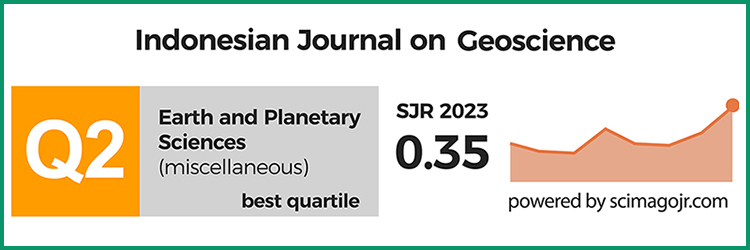Developing a Geoinformatic-engineering Stability Modeling Method, using Field Data and GIS Environment: A Case Study from Al Qarara Area in Wadi Musa, Jordan
DOI:
https://doi.org/10.17014/ijog.2.1.1-21Keywords:
geo-engineering stability, landslide, developing modeling method, GIS, spatial modeling, field mappingAbstract
By applying detailed geological field surveys, the spatial factors affecting geo-engineering stability were used to develop a geo-engineering stability modeling method to identify areas under potential threat of landsliding. The factors affecting geo-engineering stability in Al Qarara area in Petra-Jordan were studied and given assumed rates of importance, where optimization process was run by lag iterations; the produced spatial layers of the different factors were gathered and modeled using GIS; a final stability map was produced using an optimized equation. The produced map was validated qualitatively and quantitatively, where a comparison was made between the reality in the field and several maps of different equation. The modeling method which was developed in the context of this study proved to be suitable to produce micro-zonation maps of areas having landslide risk. Further applications on the method in other areas suffering landslides will further improve it.
References
Abderahman, N. (1994). Rock Fall in Zarqa River, Northern Jordan, Abhath AL-Yarmouk "Pure, Sel. And Eng." Vol. 3, No. 2, PP. 111-122.
Abderahman, N. (1996). Amman-Jerash highway Landslide (Case study: South of Jerash New Bridge. Abhath AL-Yarmouk, Pure Sc. and Eng., Vol. 5, No 2, PP . 177-196.
Abderahman, N. (1998) Landslide at km 56.4 Along the Irbid-Amman Highway, Northern Jordan. The American Association of Petroleum Geologists, Division of Environmental Geosciences. Vol.4.
Al-Basha, S. (1996) Geomechanical Characteriyation of rock slopes along Amman-Jerash-Irbid. Highway, M.Sc. Thesis, University of Jordan, Amman, Jordan.
Aleotti, P., Chowdhury, R., (1999) Landslide Hazard Assessment: Summary, Review and New Perspectives. Bull. Eng. Geol. Environ. 58, 21-44.
Al-Homoud A. S., Prior, G., Awad, A., (1999). Modeling the Effect of Rainfall on Instabilities of Slopes Along Highways. Environmental Geology 37, 317- 325. DOI:10.1007/s002540050390
Al Farajat, M., (2002): Hydrogeo-Ecosystems in Aqaba –Coasts and Region; Natural Settings, Impacts of Land Use, Spatial Vulnerability to Pollution and Sustainable Management. Uni-Wuerzburg, Hydrogeologie und Umwelt, Würzburg-Germany
Al Farajat, M., (2008): " Combined Seismic Refraction and Geomagnetic Surveys on Hills of Industrial Wastes of Gypsum in Aqaba for Stability Hazards" Jordan Journal of Civil engineer (JJCE), Jordan University of Science and Technology, Ramtha-Jordan, Volume 3, No. 1, 2009
Anbalagan, R., (1992). Landslide hazard evaluation and zonation mapping in mountainous terrain. Eng. Geol. 32, 269-277. DOI:10.1016/0013-7952(92)90053-2
Atallah, M. (1996). Joint and fault analysis in Al-Husn fold belt -northern Jordan. Abhath Al-Yarmouk, Series of Basic Sciences and Engineering 5, 187-201.
Attenwell, B. and Taylor, R. K., (1984) Ground mevements and their effects on structures, New York, chapman and Hall
Bell, F. G. (1993) Engineering Geology. Black Well Publications London. 359P.
Blyth, F. G. H. (1946) A Geology for Engineers, The English Language Book Society and Edward Arnold. London. 341P .
Bender, F., (1968). Geology of Jordan. Borntraeger, Berlin. 196 p.
Chowdhury, R. N. (1978). Slope Analysis. Elsevier, Amsterdam. 423P. DOI: 10.1177/030913338100500312
Dames and Moore Co. (1993). Final Report, Geotechnical Studies, Irbid-Jerash Amman Highway , Unpublished.
Diabat, A., (1999). Paleostress and strain analysis of the Cretaceous rocks in the eastern margin of the Dead-Sea Transform, Jordan. Ph.D. Thesis, Baghdad University, Iraq.
Diabat, A. (2009). Structural and stress analysis based on fault- slip data in the Amman area, Jordan. Journal of African Earth Sciences 54, 155-162.
Diabat, A., (2013). Fracture systems of granites and Quaternary deposits of the area east of Aqaba: indicators of reactivation and neotectonic activity. Arabian Journal of Geosciences, Vol. 6, No. 3: 679-695. DOI:10.1007/s12517-0011-0389-1
Diabat, A., and Masri, A.,(2005). Orientation of the principal stresses along Zerqa- Ma,in Fault. Mu,ta Lil-Buhuth wad-Dirasat, 20: 57- 71.
Diabat, A., Atallah, M., and Salih, M., (2004). Paleostress analysis of the Cretaceous rocks in the eastern margin of the Dead Sea transform, Jordan. Journal of African Earth Sciences 38, 449-460. DOI:10.1016/j.jafrearsci.2004.04.002
El-Naqa, A (2006) Application of SINMAP terrain stability model along Amman-Jerash-Irbid highway, North Jordan. Electronic Journal of Geotechnical Engineering, Bunde B.
Eyal, Y., (1996). Stress field fluctuations along the Dead-Sea Rift since the middle Miocene. Tectonics 15,: 157-170. DOI:10.1029/95TC02619
Eyal, y., and Reches, Z., (1983). Tectonic analysis of the Dead Sea Rift region since the late Cretaceous based on mesostructures. Tectonics 2, 167-185. DOI:10.1029/TC002i002p00167
Freund, R., Zak, I., Garfunkel, Z., (1968). Age and rate of the sinistral movement along the Dead Sea rift. Nature 220, 253-255. DOI:10.1038/220253a0
Garfunkel, Z., (1981). Internal structure of the Dead Sea leaky transform (rift) in relation to plate kinematics. Tectonophysics 80, 81-108. DOI:10.1016/0040-1951(81)90143-8
Goodman, R. E. (1980). Introduction to rock mechanics. John Wily and sons. 478 P.
Johnson, R, B, and Sitar, D, S. (1990). Principles of Engineering Geology. John-Willy and sons Inc, Canada P. 497.
Kashai, E.L., and Croker, P.F., (1987). Structural geometry and evolution of the Dead Sea– Jordan rift system as deduced from new subsurface data in: Z. Ben-Avraham (Eds.), Sedimentary basins within the Dead Sea and other rift zones. Tectonopysics 141, 33-60. DOI:10.1016/0040-1951(87)90173-9
Kersten, R. W. O. (1990). The Stress Distribution Required for Fault and Joint Development. Proceedings of the International Conference of Mechanics of Jointed and Faulted Rock, Vinna, Astria, H. P. Rossmanith (ed.), Blakema, Rotterdam, 251 P.
Longley, P. A., Goodchild, M. F., Maguire, D. J. & Rhind D.W., (2001) Geographic Information Systems and Science, John Wiley & Sons, Ltd. DOI:10.1080/041431161.2011.587098
Malkawi, A., Saleh, B, Al-Sheraiadeh, M. and Hamza, M (2000) Mapping of landslide Hazard Zones in Jordan Using Remote Sensing and GIS. Journal of Urban Planning and Development, ASCE,126 (1): 1-17. DOI:10.1061/(ASCE)0733-9488(2000)126:1(1)
Mansour, Z. M. (1994). Geological and Geotechnical Studies of the Slides and Failures Along Jerash-Amman Highway: Unpublished. M. Sc thesis, Yarmouk University.
Massant, Y., , (1988). Marls in Jordan, Geology Properties and Engineering Problems, Dirasat University of Jordan, V. 141, No. 6PP (44-67).
Powell, J. H., 1989. Stratigraphy and sedimentation of the phanerozoic rocks in central and south Jordan. Geological mapping division, natural resources authority, Jordan, Bulletin 11, 130 p.
Muhaidat, A., (2010). Stability analysis of slopes along As-Salt Wadi Shueib Road .
Priest, S. P. (1993). Discontinuity analysis for rock Engineering. Chapman and Hall. London 473 P. DOI:10.1007/978-94-011-
-1
Quennell AM. (1951). The Geology and mineral resources of former Transjordan. Colon Geol Min, Resource, 2, 85-115, London.
Quennell, A.M., (1958). The structure and evolution of the Dead Sea Rift. Quaternary Journal of the Geological Society 64, 1-24.
Quennell, A.M., (1959). Tectonics of the Dead Sea Rift. Proc. Of the 20th Inter. Geol. Congr. Mexico, Ass. de serv. Geol. Africanos, 385- 403.
Quennell, A.M., (1983). Evolution of the Dead Sea Rift. A review, First Jordanian Geologic Conference 460-482.
Ron, H., Eyal, Y., (1985). Intraplate deformation by block rotation and mesostructures along the Dead Sea transform, northern Israel. Tectonics 4, 85-105. DOI:10.1029/TC004i001p00085
Sanderson, F., Bakkehøi, S., Hestenes, E., and Lied, K. (1996) : The influence of meteorological factors on the initiation of debris flows, rock falls, rockslides and rock mass stability, in: Landslides. Proceedings 7th International Symposium on Landslides, edited by: Senneset, K., A.A. Balkema, 1.
Sharpe, C. F. S. (1950). Mechanisms of landslides. In application of geology to engineering practice, Berkey volume 1. Boulder Colo: Geological Society of America.
Terlien, M. T. J. (1998) The determination of statistical and deterministic hydrological landslide-triggering thresholds, Environ. Geology, pp 35, 2–3. DOI:10-1007/s002540050299
Varnes, D. J. (1978) Slope movements and types and processes, in Schuster, R. L., and Krizek, R. J., eds., Landslides: Analysis and control: Transportation Research Board, National Academy of Science, Special Report 176, p. 11-33
Zain Eldeen, U., Delvaux, D., Jacobs, P., (2002). Tectonic evolution in the Wadi Araba Segment of the Dead Sea Rift, Southwest Jordan. EGU Stephan Mueller Special Publication Series 2, 63- 81.
Zolfaghari, A. R., and Heath, A. C., (2008) A GIS application for assessing landslide hazard over a large area. Computer and Geotechniques 35, 278-285. DOI:10.1016/j.compgeo.2007.03.007



















